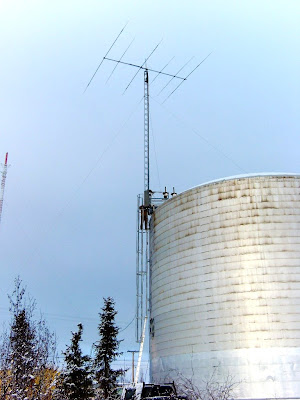I was fully expecting this year's event to be a dismal failure. The geomagnetic field was predicted to be active all weekend. At this latitude, active geomagnetic conditions and low solar flux means no contacts on HF. Fortunately, Gabriel (the patron saint of ham radio) was still keeping an eye on us after our antenna raising last weekend and arranged for a flurry of sun spots to make up for the aurora.
Our only goals this year were to break the VE8 M/2 record we set last year and to make over a thousand contacts. Even with eight hours of auroral induced 'off-time' early Sunday morning conditions were otherwise very good and by Sunday afternoon both items were in the bag.
Lots of highlights over the weekend, here's the Top Ten List:
1. Starting the contest with a 100-hour on 20m. Now that's hitting the air running!
2. The excellent conditions on 40m Friday night. I worked all continents in the same hour just after midnight local time.
3. The surprise opening on 15m to Europe at 4am local time Saturday morning.
4. Working SU1KM in Zone 34 on Saturday morning for my LAST zone for the CQ WAZ award.
5. Working not one but TWO other VE8 stations (VE8DAV and VE8NSD) and VY0HL. Zero points for the contest but still cool and unusual!
6. Pushing the rate meter past 200 running stateside and JA stations late Saturday afternoon.
7. Having Wally ask me to work a Brazilian station on 15m that he'd been calling for 10 minutes with no success. He meant for me to use the big yagi and my amplifier but instead I just picked up his headset and made the contact with my first call. I told him the secret was "timing, tone and annunciation" ;)
8. Working several all-time new ones for DXCC. I've got to comb through the logs to find out which ones but I know for sure Tonga and Fiji and I'm pretty sure there's one or two more.
9. Working DP1POL in Antarctica on Sunday afternoon. I came across him CQing by himself and didn't even realize where he was until I put his call in the computer. We both said "Wow!"
10. Hunting multipliers off the cluster on Sunday afternoon I dialled up the QRG of some Caribbean station and the very first thing I heard was "who's the station with Victor?" I quickly threw out my callsign and into the log he went!

VE8DW shows off the broken record after finishing up on Sunday.
That's all until the next one. Thanks for all the Q's and we'll see you in Sweepstakes!
73 de VE8EV


